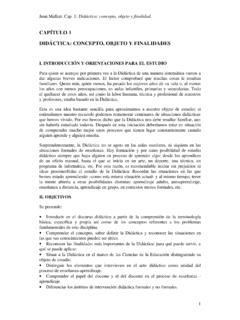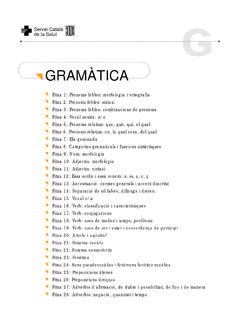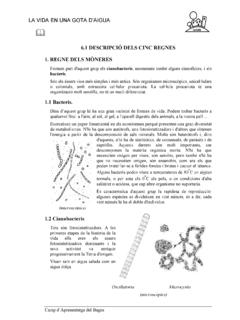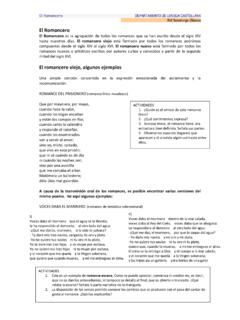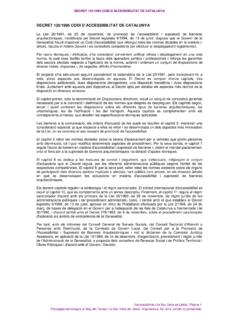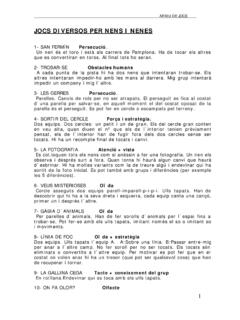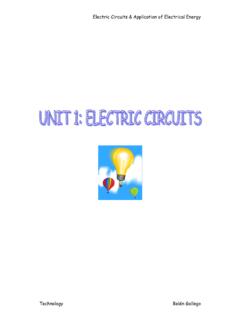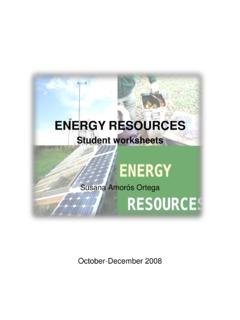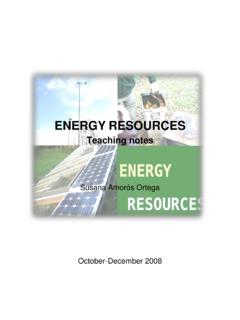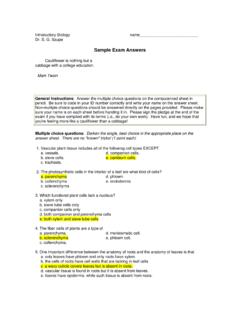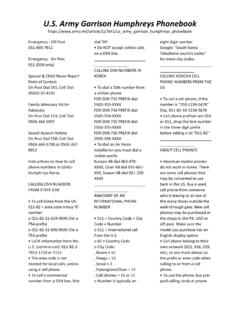Transcription of PLANT REPRODUCTION
1 PLANT REPRODUCTION . Students' worksheets Janet Huguet January March 2009. PLANT REPRODUCTION . HOW TO CLASSIFY. Lesson 1 Name _____. Introduction How to classify Everyday, you classify. Think about it. Sorting objects and putting them in a specific place is classification. Practise classifying objects according to physical structure and characteristics. Activity 1 - Living and non-living things In this activity we are going to compare and classify a set of pictures. How can they be grouped? How can they be studied? What keys are used to organize these objects into the following groups? .. Activity 2 - Sorting game. Choose a creature and try to work out which one has your classmate picked. Lizard Goldfish Owl Rabbit Snail Spider Butterfly Crab Ask Questions like these: Is A mammal?
2 Fly? Legs? Does it have Wings? Fur? A vertebrate? Can Warm blooded? Backbone? HUGUET FIT , Janet CEIP Antoni Roig PLANT REPRODUCTION . HOW TO CLASSIFY. 3 - How can you classify these animals? (fig 1) Name _____. CLASSIFY ANIMALS: dog, horse, bird, snake, crocodile, sardine, butterfly, whale, golden eagle, alligator, donkey, penguin, hake. FISH AMPHIBIANS REPTILES BIRDS MAMMALS. Warm-blooded or Cold-blooded Type of body covering Live birth or Hatched from egg Feed young with milk (yes/no). Has a skeleton Breathes with lungs or gills HUGUET FIT , Janet CEIP Antoni Roig PLANT REPRODUCTION . HOW TO CLASSIFY. ANIMAL KINGDOM CLASSIFICATION (fig 1). Living things Animal Kingdom PLANT Kingdom Invertebrates Vertebrates Absence of vascular tissue Presence of vascular tissue .. Live in water Walk & swim Body covered in scales Have wings Body covered in hair or fur Breathe with gills Breathe with gills & lungs Breathe with lungs Body covered in feathers constant body have skeleton Lay eggs in water cold blooded Beak temperature HUGUET FIT , Janet CEIP Antoni Roig PLANT REPRODUCTION .
3 HOW TO CLASSIFY. Activity 4 Name _____. The Key to living things. In pairs, classify these living things using the dichotomous key on the next sheet. Now make your own drawings and share them with other students to put into the key. HUGUET FIT , Janet CEIP Antoni Roig PLANT REPRODUCTION . HOW TO CLASSIFY. DICHOTOMOUS KEY Name _____. HUGUET FIT , Janet CEIP Antoni Roig PLANT REPRODUCTION . HOW TO CLASSIFY. Lesson 2 Name _____. Activity 1 - Living things what they need and what they can do. (fig. 2). Application Choose a PLANT , then write its name on the dotted line in the box in the table. Choose an animal and write its name on the dotted line in the middle of the box. Choose an object that has never been alive and write its name on the dotted line in the last box. Synthesis Look at your PLANT and answer each of the questions.
4 If the PLANT has the characteristics in the list, write YES in the box. If the PLANT does not have the characteristics, write NO in the box. Then repeat this for the animal and for the object you chose. In groups of threes compare your answers, you can use sentences like this: I think it is a .. because it . Activity 2. Application Now you are going to look at some pictures of animals and plants (fig 2) bee, spider, worm, mealworm, snail, dog, horse, bird, snake, crocodile, butterfly, whale, grass, ivy, holly, cherry tree, daffodil, oak tree, human which word describes these living things? Analysis Group the living things into similar groups and give the reasons for doing so. Synthesis Produce a skeleton Mind map of these groups of living things groups on a poster. Evaluation Present your poster to rest of class.
5 HUGUET FIT , Janet CEIP Antoni Roig PLANT REPRODUCTION . HOW TO CLASSIFY. - Living things what they need and what they can do. (fig 2). Characteristics A PLANT An animal An object that has never (Living things need to do all been alive. these things).. M Does it show any movement? R Does it need air or oxygen? S Does it react to what is happening in its surroundings? G Can it grow larger? R Can it make more living things like itself? E Can it get rid of waste from itself? N Does it need food for energy? HUGUET FIT , Janet CEIP Antoni Roig PLANT REPRODUCTION . HOW TO CLASSIFY. Lesson 2 (fig. 3) Name _____. Activity 3. Complete the following chart. The PLANT Kingdom Non Seed Plants Seed Plants _____ _____ _____ _____ _____. "naked seed" "seed vessel". Spores to reproduce _____.
6 Common forest trees. With needle-shape HUGUET FIT , Janet CEIP Antoni Roig PLANT REPRODUCTION . HOW TO CLASSIFY. Lesson 2. Name: _____. Activity 3. Botanists have developed a scientific classification system to group similar plants together. They make note of details about PLANT anatomy (especially that of flowers , fruit, seeds and leaves). They use these characteristics to divide plants into categories. Application Working in pairs, read at the text carefully. After that complete the PLANT kingdom classification (fig 3). At the end you can test your answers looking at slide 11 on the power point. Plants are the key to life on Earth. Without them many other living organisms would soon disappear. This is because higher life forms depend on plants, either directly or indirectly, for their food.
7 Most plants, however, are able to make their own food using sunlight. All plants fall into two basic categories. Flowering plants produce true flowers . The non-flowering plants include primitive plants, such as algae, mosses, and ferns. Horsetails, and liverworts, and the gymnosperms a group of plants which includes the conifers. There are about 3000,000 species of flowering PLANT in the world today, and they grow everywhere from snowy mountains to arid deserts. HUGUET FIT , Janet CEIP Antoni Roig PLANT REPRODUCTION . HOW TO CLASSIFY. PLANT KINGDOM. Non-Seed Plants Seed Plants Algae Mosses Ferns Naked seed Seed Vessel . Gymnosperm Angiosperms s Monocot - Petals in multiples of 3. Dicot - Petals in multiples of 5. HUGUET FIT , Janet CEIP Antoni Roig PLANT REPRODUCTION . HOW TO CLASSIFY.
8 Activity 4 Sort it game with cards. This activity is based on the card game Happy families . There are 24 cards in the pack, made up of six sets of four cards. 1. Play the game in groups of three or four players. Spread the cards out (face upwards) and then sort them into groups in whatever way you like. Then give children several minutes to discuss this. After that the children report back to rest of the class saying how they have sorted their cards and their justification for doing so. 2. Can you now sort the cards into six sets of four cards?. Again discuss in your groups how you can group the cards. HUGUET FIT , Janet CEIP Antoni Roig PLANT REPRODUCTION . HOW TO CLASSIFY. Name: _____. Revision activity 1. Use the information from the boxes to complete the questions Scientists put living things into groups to make studying them easier.
9 The two main groups are animals and plants. We can use keys to help us to identify living things. a) Why do scientists put living things into groups? _____. _____. _____. b) What is the main difference between animals and plants? _____. _____. _____. 2. Write true or false next to each statement. Living things are easier to study if they are classified. 2. _____ Classification is the process of grouping things. 3. _____ Geologists are scientists that classify living things. 4. _____Latin is the language often used by scientists to name living things. 5. _____ Living things can be grouped into five major kingdoms. 3. Discovery Carolus Linnaues. In a pair work students can look for Carl Linnaeus Biography reading the article from the Internet. HUGUET FIT , Janet CEIP Antoni Roig PLANT REPRODUCTION .
10 PARTS OF A FLOWER. DISCOVERY. CAROLUS LINNAEUS. Early naturalists tried to devise a system for naming species in a way that everyone could understand, without consideration of their language. The scheme that biologists use today was devised in the eighteenth century by the Swedish botanist Carolus Linnaeus (1707. 1778). He used Latin names, and gave all animals and plants a two-part name, such as Sturnus vulgaris for the common starling. He used the two-part name for the same reason that people have surnames and the first names: The surname shows what family they belong to and the first name belongs to the individual. Scientific names for animals and plants work in the same way as the names of people, but the order is reversed, with the surname . coming first. This surname covers a group of related species, known as genus.
